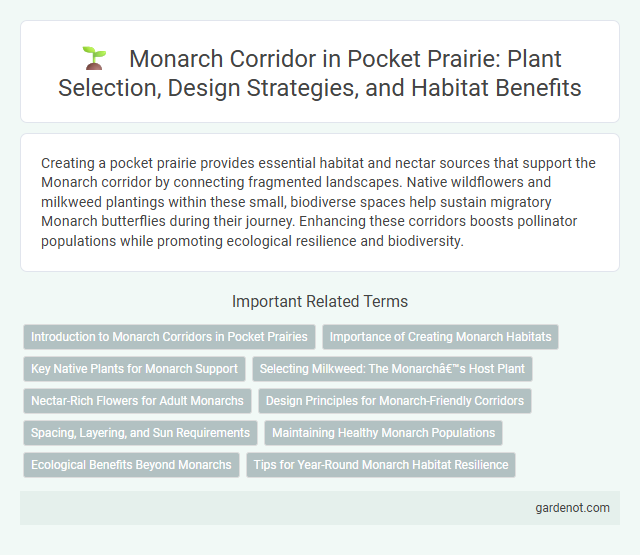Creating a pocket prairie provides essential habitat and nectar sources that support the Monarch corridor by connecting fragmented landscapes. Native wildflowers and milkweed plantings within these small, biodiverse spaces help sustain migratory Monarch butterflies during their journey. Enhancing these corridors boosts pollinator populations while promoting ecological resilience and biodiversity.
Introduction to Monarch Corridors in Pocket Prairies
Monarch corridors in pocket prairies provide essential habitats that support the lifecycle of monarch butterflies by offering milkweed and nectar-rich plant species. These corridors enhance connectivity between fragmented landscapes, facilitating monarch migration and breeding patterns. Implementing diverse native flora within pocket prairies strengthens ecosystem resilience and promotes pollinator biodiversity.
Importance of Creating Monarch Habitats
Creating monarch habitats within the Monarch Corridor is vital for supporting the endangered monarch butterfly population, which has declined by over 80% in recent decades. Pocket prairies provide essential nectar sources and breeding grounds that sustain monarch migration and reproduction cycles. Establishing continuous patches of native milkweed and diverse flowering plants enhances habitat connectivity, promoting genetic diversity and resilience against environmental threats.
Key Native Plants for Monarch Support
Milkweed species such as Common Milkweed (Asclepias syriaca) and Butterfly Milkweed (Asclepias tuberosa) are essential for Monarch butterfly reproduction, providing critical larval food sources. Native nectar plants like Purple Coneflower (Echinacea purpurea) and Goldenrod (Solidago spp.) supply vital energy for adult Monarchs during migration. Incorporating these plants into pocket prairies creates a sustainable monarch corridor, enhancing habitat connectivity and supporting population resilience.
Selecting Milkweed: The Monarch’s Host Plant
Selecting milkweed species native to your region ensures the highest survival rate for Monarch caterpillars, as they rely exclusively on these plants for egg-laying and larval feeding. Common milkweed (Asclepias syriaca) and swamp milkweed (Asclepias incarnata) provide essential nutrients and habitat, promoting healthy Monarch populations along the Monarch corridor. Incorporating diverse milkweed varieties supports Monarch migration by extending nectar availability throughout the breeding season.
Nectar-Rich Flowers for Adult Monarchs
Monarch corridors rely heavily on nectar-rich flowers such as milkweed, coneflowers, and goldenrods to sustain adult monarch butterflies during migration. These plants provide essential energy sources that support long-distance flight and reproductive success. Incorporating diverse native nectar plants in pocket prairies enhances habitat connectivity and promotes monarch population resilience.
Design Principles for Monarch-Friendly Corridors
Design principles for Monarch-friendly corridors emphasize native milkweed planting as essential habitat for monarch larvae and nectar plants to support adult butterflies throughout migration. Spatial arrangement prioritizes contiguous, pesticide-free zones with diverse flowering species blooming sequentially from spring to fall to provide continuous resources. Incorporating shelter such as shrubs and minimizing light pollution enhances monarch survival by offering refuge and safe navigation within pocket prairie ecosystems.
Spacing, Layering, and Sun Requirements
The Monarch corridor thrives when pocket prairies incorporate strategic spacing, allowing ample room for butterfly movement and nectar access. Layering native plants of varying heights creates ideal microhabitats and supports the monarch's lifecycle stages effectively. Full sun exposure is crucial, as monarch butterflies depend on warmth for flight and milkweed growth, which is essential for caterpillar feeding.
Maintaining Healthy Monarch Populations
The Monarch corridor relies on preserving native milkweed species and diverse nectar plants to support healthy monarch populations throughout their migration. Habitat restoration and reduced pesticide usage in pocket prairies enhance breeding and feeding opportunities for monarch butterflies. Continuous monitoring of population health aids in adapting conservation strategies to ensure the survival of this vital pollinator species.
Ecological Benefits Beyond Monarchs
The Monarch corridor within Pocket prairie habitats provides critical ecological benefits extending beyond supporting Monarch butterfly populations by enhancing biodiversity and stabilizing local ecosystems. These prairie strips increase pollinator diversity, improve soil health through deep-rooted native plants, and create habitat connectivity that benefits numerous species including bees, birds, and small mammals. Preservation of these corridors promotes resilience against climate change impacts and supports ecosystem services such as pest control and nutrient cycling.
Tips for Year-Round Monarch Habitat Resilience
Creating a resilient Monarch corridor requires planting diverse native milkweed species that bloom sequentially throughout spring, summer, and fall to provide continuous forage and breeding grounds. Incorporate native wildflowers and grasses to enhance habitat complexity, supporting nectar availability and shelter while improving soil health. Regularly monitor for invasive species and pesticide use, applying integrated pest management strategies to maintain a safe environment for Monarch larvae and adults year-round.
Monarch corridor Infographic

 gardenot.com
gardenot.com